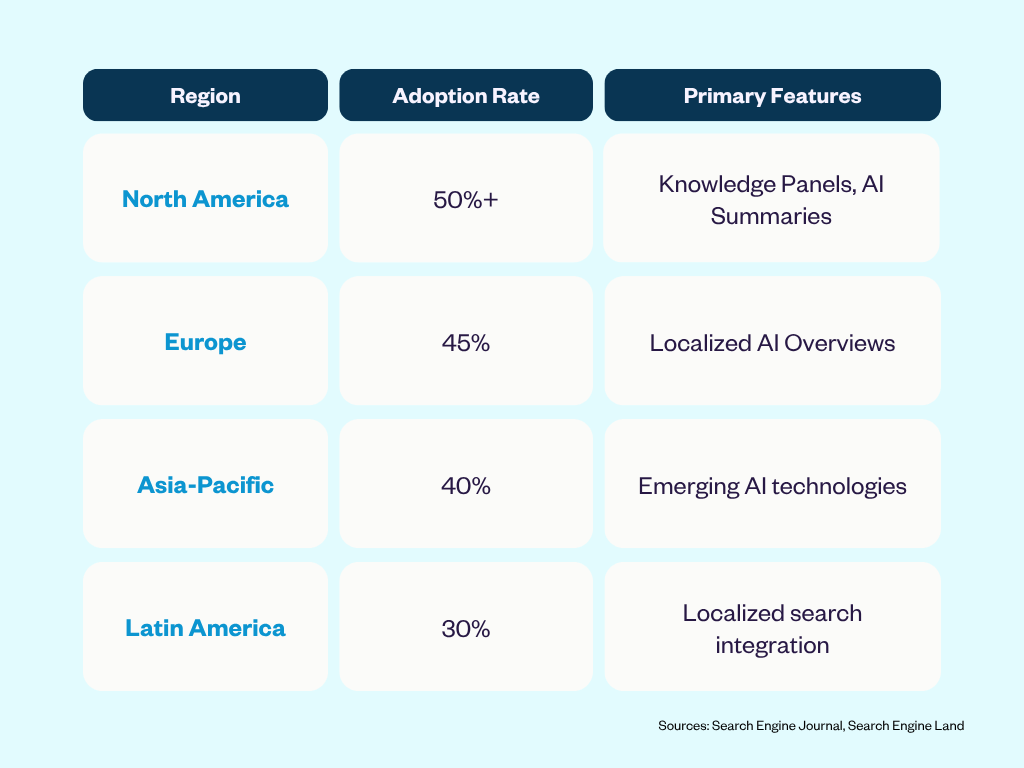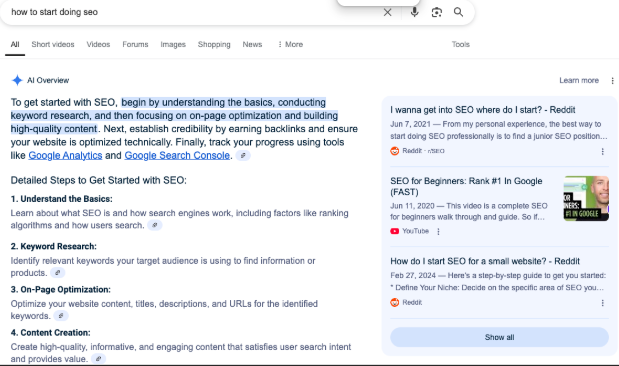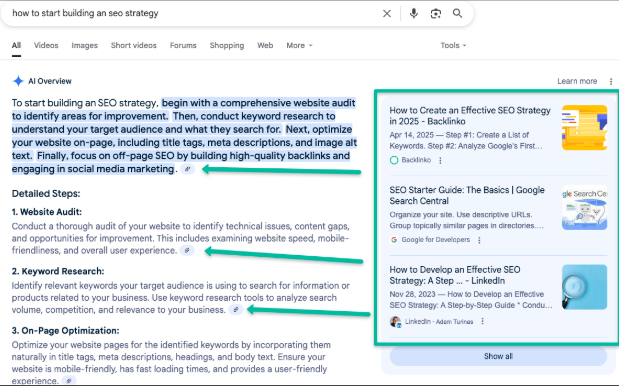Generative AI features creeping onto the search results pages has been just about the biggest topic in Organic Search, Google especially. SERP elements like Google’s AI Overviews have been appearing for a greater amount of searches. Some of the most recent research out there has found that AI Overview placements grew 116% since March of 2025, with 13% of all queries in Google triggering an AI Overview (a 6% increase from January) and 47% of all global searches featuring some kind of AI-enhanced feature.
The concern among many brands and vendors right now is that the continued expansion of these kinds of AI-driven elements in search results could decrease the amount of site visitors and revenue they generate from Search traffic, Organic Search in particular. On the flip side, having one’s brand cited in an Overview could also provide a boost to said KPIs.
Implications of More AI Overviews in Google Search
Websites featured in AI Overviews often experience higher ranking fluctuations compared to standard organic search results. According to recent data from industry reports, AI-driven SERP rankings can change by as much as 30% within a week, depending on content freshness and source credibility.

*More information here 1 , 2 , 3
It’s clear that changes to search are already happening. Here’s a list, straight from some of our internal Generative Engine Optimization (GEO) documentation, of some of the most impactful changes so far:
- Altered Click-Through Rates (CTR): AI Overviews provide instant answers, reducing users' need to click through to websites. A 2025 study from Bain & Company found that 60% of searches end without the searcher making any clicks on the SERP
- Content Selection Refinement: Fluctuations in AI Overview appearances suggest that Google is frequently testing and refining the AI’s content selection process.
- Emphasis on Authority: Content from authoritative sources tends to be favored, highlighting the need for strong E-E-A-T (Experience, Expertise, Authoritativeness, Trustworthiness) signals.
All that said, it’s important to maintain some perspective before jumping to extreme pessimism or optimism about the potential impact on your organic traffic. The concept of a new, more interactive element being introduced to the results page and disrupting click-through rates and ranking signals is nothing new.
History of the “Zero-Click” SERP
This isn’t the first time something like this happened in Organic Search. Google has previously rolled out so-called “zero-click” SERP features. Here are a few examples leading up to AI Overviews:
Featured Snippets
Featured snippets first rolled out on Google SERPs all the way back in 2014. Snippets take information from authoritative sites and present them directly on the SERP. This includes a variety of formats including lists, tables, YouTube thumbnails, product carousels, and paragraphs:

At the time of their introduction they were one of the first disruptions to the “above-the-fold” section, the part of the SERP below the search bar but preceding Position 1 in the actual organic rankings. Following their launch, Featured Snippets saw aggressive growth across Google search, reaching 12% of total search queries in 2021.
Voice Search
Technically voice is less a SERP element as a different way of interacting with organic search results via voice-enabled devices like phones, tablets, and smart home devices. However, the discourse around voice search around the time of its introduction was similar to that for featured snippets and AI Overviews, especially when research showed that 80% responses to voice search queries were from the top 3 web search positions, 60% of those being associated with a Featured Snippet result.
What’s important to note is that while these features did have a measurable impact on clickthrough rates in Organic search, they didn’t eliminate Organic clicks altogether, far from it.
The Goal of Zero-Click SERP Elements
When trying to figure out how your brand should respond to Overviews, it’s worth keeping in mind why search engines like Google implements SERP elements like AIO and Featured Snippets to begin with.
The goal of elements that surface copy directly on the SERP is to present searchers with a single targeted answer to their search query. This predisposes these elements, Overviews included, to mainly appear in response to a specific category of search.
Where is Overviews’ Impact the Most Pronounced?
The latest research available finds that AIO is most commonly found on medical, financial, and general how-to queries. What we at BMG360 along with various analysts in the SEO space have noticed is that the majority of topics affected by AIO are indeed informational in nature. That is to say, longer searches that use natural sentence structure and are often looking for answers to a specific question or how-to instructions.

For the time being more commercial and transactional searches, like people searching for specific products or services, are less affected, though this can obviously change as Google continues to iterate on AIO and roll it out to more SERPs.
Putting AIO Impact in Perspective
The impact of Overview on Organic traffic is undeniable. BrightEdge’s May 2025 research found that average click-through rates dropped 30%. The suggestion here is that the continued rollout of AI Overviews in Q1 of 2025 contributed to that decrease in click-through rates.
There are a couple of nuances to keep in mind when thinking about that impact on CTRs and what it might mean for your business.
Zero-Click Historical Perspective
As we noted above, this isn’t the first time Google has rolled out zero-click elements on an experimental basis. Serving searchers with curated answers to their queries directly on the SERP is a goal Google’s been pursuing for more than a decade now in various forms, Overviews being the latest iteration.
Some decreases in average click-through rates were observed at that time as well. Featured Snippets as a whole earned 42% of total click share over traditional search results. At the same time, sites cited in the Quick Answers saw definitive increases in clicks in that premium SERP real estate. What didn’t happen, however, is a collapse or irrelevance of traditional Organic search traffic.
So while Overviews might negatively impact CTR for traditional Organic rankings for the time being, that’s not guaranteed to be a permanent thing. Additionally, especially as more clarity is hopefully provided and SEO testing is carried out, orienting your site content to be cited in relevant Overviews could be a way of augmenting your top-funnel traffic strategy.
Overviews and Your Business Goals
When evaluating the impact of Overviews on your business, be sure to keep your full funnel in perspective. While the CTR impact of Overviews is real and well documented as of the time of this post, the impact further down the conversion funnel is going to vary a lot based on the type of business or organization in question.
Three initial questions to ask:
1. What does the bottom of your site’s conversion funnel look like? (Translation: what’s the ultimate goal or action your site is encouraging visitors towards taking?)
2. Where on your site do the majority of your visitors convert into customers, clientele, or leads?
3. Has there been any change in conversion rates (CVR) on your bottom-funnel goals?
It’s entirely possible that, depending on your business model, you may not be seeing as big of an impact closer to your business as you are up at the top of the funnel. While site visitors who come in via informational searches are absolutely valuable as potential customers, they typically have lower consumer intent than people searching for, say, service features or pricing details and landing on product pages – an intent that so far has been much less impacted by Overviews.
Overviews and Google’s Business Goals
Providing Google searchers with an immediate answer to their question is the goal of Overviews. While we are observing that this reduces average click throughs across the SERP, so far there’s been little indication that Google intends to replace Organic search entirely with LLM-generated AI responses.
Google has a vested interest in maintaining the quality and user experience of standard Organic search. There’s an element of the public good to that – assertions have been made that Google search should be a public utility and the fidelity of organic search results is important enough that – but also a strong commercial incentive:
- Google makes much of its revenue from Google Ads. This is a marketplace where vendors bid to appear in results for relevant topics or individual keywords
- Google Ads as an advertising platform derive their value from the amount of eyeballs going to Google every day. Basically, a keyword group is worth bidding on because the average amount of people searching those keywords is quantifiable
- Google’s dominance in share of searcher eyeballs, 79% as of March 2025, exists in part because of the quality of its organic search results, implementing algorithms to sort and rank sites based on their relevance to the searcher and providing more accurate organic search results than other existing search engines.
Because of the above, it wouldn’t be in Google’s interest to retain any features that hurt organic search volumes. In a hypothetical scenario where AI Overviews were able to serve high quality and comprehensive answers to all queries, including those searching for products and services, the value of the average Google Ad placement would decline, harming Google’s bottom line.
New SERP Element Rollouts and User Engagement
Google does iterate on and evolve new SERP features over time. Many algorithm updates over the years have included modifications to featured snippets. We’ve also seen the amount and type of keywords change over time. All of that is to say that the rollout of features like Overview has never been a purely linear progression – user experience matters to Google and things can and do change based on user sentiment.
We should assume that elements of features like Overview that are negative for searchers and sites will be ironed out over time, because Google has that vested commercial interest in doing so. And for the time being the use of traditional search continues to be strong. (there are 5 trillion Google searches per year alone) It’s fair to assume that consumers will continue to discover brands that way in the immediate future, whether that’s on Google, generative engines like ChatGPT and Gemini, or competing search engines like Bing.
How to Optimize for AI Overviews
There are potential SEO advantages to Overviews to keep in mind as well.
Overviews contains links and brand mentions to the sites it uses to generate its responses. These are a compelling new way to potentially drive more clicks from Google, since they occupy prime real estate at the top of the SERP.

Overviews is a product that continues to iterate upon itself and evolve over time. That said, there are a number of website factors that should be front and center when evaluating whether your brand is well positioned. Here’s an overview of some of them, courtesy of BMG360’s own GEO triage and best practices documentation:
- Content architecture - A modular content structure improves readability and compatibility with AI parsing.
- Schema tagging & structured data - Schema markup enhances content visibility by structuring data in machine-readable formats.
- Robots meta tag - The robots meta tag is a crucial element in determining how Google processes and displays content in search results, including AI Overviews. Google's latest updates specify that AI Mode and AI Overviews adhere to directives such as nosnippet and max-snippet, directly affecting how content is included in AI-generated results.
- Map user intent - Aligning content with user search intent requires detailed keyword research and audience analysis. Evaluate which of your traffic-driving keywords, or target keywords you may want to rank for, and how closely aligned they are to actual transactional/commercial intent.
- Integrate language model considerations - Language models like Gemini power many AI Overviews by reading and summarizing web content, then predicting the next most logical word, code, etc. These are designed to identify well-structured, relevant information, emphasizing the importance of clear headings, concise answers, and robust internal linking.
If you’re seeing CTR dips or unsure how your SEO content stacks up against Overview AI and other SEO changes, we can help assess the gaps. Get in touch with us, or check out our other articles to stay up to date on best practices.
The Complete Guide to Effective Keyword Research for SEO
The Manual Link Building Guide for Effective Website Promotion
How to Use AI for SEO and Boost Organic Traffic
About the Author
This article was written by Mark Aspillera, Senior SEO Strategist at BMG360. Part SEO strategist, part client whisperer, Mark leads search strategy and client services for a tight roster of high-end national and international brands. From setting the big-picture SEO roadmap to running the day-to-day, he makes sure every tactic maps back to what actually moves the needle. If he's not deep in a rank report or a strategy doc, he's probably on a client call making complex things sound simple.
Mark also just published a new, complete Guide to Keyword Research in 2025. Get it below.
